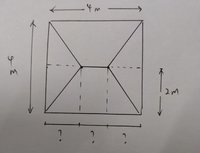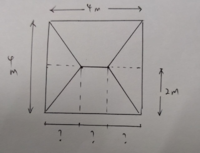You are using an out of date browser. It may not display this or other websites correctly.
You should upgrade or use an alternative browser.
You should upgrade or use an alternative browser.
How to find the lengths indicated by the 3 question marks in this diagram?
- Thread starter JHY
- Start date
Is that a sub-division of a square? If you don’t tell us, how can we know?
Is there other information that you failed to tell us?
It says in Read Before Posting to give the complete and exact wording of the problem? You did read that, didn’t you?
Is there other information that you failed to tell us?
It says in Read Before Posting to give the complete and exact wording of the problem? You did read that, didn’t you?
Thank you for replying. It is a question asked by a friend of mine, and these are the only information given to me. I really don't have any other information.When I asked my friend for extra information before posting the question here, my friend told me that she doesn't have any extra information.
One of the reasons we ask for complete and exact statements of the problem is that students frequently miss information that is relevant. One of the things to learn in math is how to dig out all the information that may be relevant.Thank you for replying. It is a question asked by a friend of mine, and these are the only information given to me. I really don't have any other information.When I asked my friend for extra information before posting the question here, my friend told me that she doesn't have any extra information.
Steven G
Elite Member
- Joined
- Dec 30, 2014
- Messages
- 14,603
While it is true that these length can be any number <=4 that statement troubles me a bit. The sum still must add up to 4. So yes you can choose the 1st number (or 2nd number or 3rd number) to be whatever you want the other two numbers will have a restriction on them.
Dr.Peterson
Elite Member
- Joined
- Nov 12, 2017
- Messages
- 16,871
What we'd really like to know, which has been hinted at, is what the purpose of this figure is. Your friend may think there is no additional information to give because they don't know any more numbers, but there may be a lot more to deduce from the meaning of the figure.Thank you for replying. It is a question asked by a friend of mine, and these are the only information given to me. I really don't have any other information.When I asked my friend for extra information before posting the question here, my friend told me that she doesn't have any extra information.
For example, it could be the top view of a 3-D object like a hipped roof of a house; there is one such figure (associated with a dodecahedron) that has very definite dimensions. Or maybe the goal is to minimize the lengths of the lines, or something like that, which could lead to particular dimensions.
So the big question is, why are they asking about it? What is it for?
D
Deleted member 4993
Guest
1st number (or 2nd number or 3rd number) ..... could be zero(0)While it is true that these length can be any number <=4 that statement troubles me a bit. The sum still must add up to 4. So yes you can choose the 1st number (or 2nd number or 3rd number) to be whatever you want the other two numbers will have a restriction on them.
Steven G
Elite Member
- Joined
- Dec 30, 2014
- Messages
- 14,603
Sure, but single out 0?1st number (or 2nd number or 3rd number) ..... could be zero(0)
D
Deleted member 4993
Guest
Because 0 is the loneliest number you will ever know ....Sure, but single out 0?


